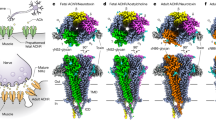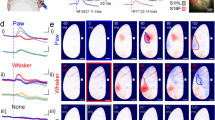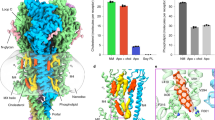Abstract
THE process by which acetylcholine causes muscle to contract presumably includes an action of acetylcholine on a definite site. The exact nature of this site, whether it is a small molecule, or a protein or enzyme, or a membrane, is still unknown. Although it is still inexactly defined, this substance or structure has acquired the presumably synonymous names ‘cholinergic receptor’ and ‘acetylcholine receptor’1,2. This communication offers evidence that the receptor structure of smooth muscle includes a chemical grouping capable of being acetylated, and that this acetylation process is a part of the chain of events that leads to contraction.
This is a preview of subscription content, access via your institution
Access options
Subscribe to this journal
Receive 51 print issues and online access
$199.00 per year
only $3.90 per issue
Buy this article
- Purchase on SpringerLink
- Instant access to full article PDF
Prices may be subject to local taxes which are calculated during checkout
Similar content being viewed by others
References
Waser, P. G., J. Pharm. and Pharmacol., 12, 577 (1960).
Ehrenpreis, S., Biochim. Biophys. Acta, 44, 561 (1960).
Geiger, W. B., J. Org. Chem., 23, 298 (1958).
MacIntosh, F. C., and Perry, W. L. M., in Methods in Medical Research, 3, 78 (Year Book Publishers, New York, 1950).
Boyer, J. H., J. Amer. Chem. Soc., 74, 6274 (1952).
Burgen, A. S. V., Burke, G., and Desbarats-Schonbaum, M. L., Brit. J. Pharmacol., 11, 308 (1956).
Author information
Authors and Affiliations
Rights and permissions
About this article
Cite this article
GEIGER, W., MANDEL, J. Quasi-Cholinergic Action of Acetylating Agents. Nature 196, 1106 (1962). https://doi.org/10.1038/1961106a0
Issue date:
DOI: https://doi.org/10.1038/1961106a0



